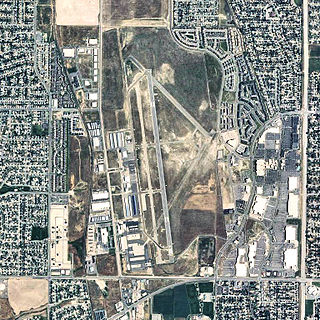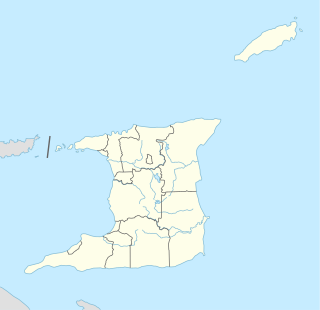An air support base (air support command base for those bases designated for the "five air support command headquarters" [1] :136a--I, II, III, IV, V Air Support Commands*) were dozens of United States Army Air Forces military installations created near Continental United States camps/forts of the Army Ground Forces. The bases were developed as part of the "air support base development program" when National Guard observation squadrons inducted into federal service in 1940-1941 had insufficient facilities to conduct their training. In 1941 HQ USAAF had an Air Ground Support Section which had documented Air Support Base Requirements and on 1 December 1942, the AAF published the entire Station List for support bases. [2]
The III Reconnaissance Command was a United States Army Air Forces unit. Its last assignment was with Third Air Force stationed at Rapid City Army Air Base, South Dakota. It was inactivated on 8 April 1946.
The II Air Support Command is an inactive United States Air Force unit. It was last assigned to Second Air Force, based at Biggs Field, Texas. It was inactivated on 22 December 1945.
The III Air Support Command was a United States Army Air Force formation. Its last assignment was with Third Air Force stationed at Drew Field, Florida. It was inactivated on 16 March 1942.
Four support bases were each named for its army post (Camp Atterbury Army Airfield, Camp Breckenridge Army Airfield, Camp Campbell Army Airfield, & Camp Davis Army Airfield), one base supported two army posts (Camps Claiborne & Beauregard), and at least three army posts each had two support bases (e.g., Camp Blanding, Camp Shelby, and Indiantown Gap Military Reservation). [2] Each airfield was either constructed or the "air support field" was leased [1] :138 from an existing owner (e.g., municipal airfields built by the Civil Aeronautics Administration). Air support bases were generally adjacent to the army post using additional federally-acquired land (e.g., Santa Maria Army Airfield at Camp Cooke), but airfields were built on some of the large Army reservations (e.g., Fort Dix Army Airfield). Most of the existing airfields that were selected were away from the post, e.g., the 1926 Colorado Springs Municipal Airfield ~10 mi (16 km) from Camp Carson), and the airbase was subsequently built adjacent (Army Air Base, Colorado Springs, was next to the airfield later named Peterson Field.) Although planned as support bases, many of the bases were assigned other primary missions, e.g., for reconnaissance, bombardment, or other training (Esler Field remained only a support base), and a few of the airbases and posts became a single military facility, e.g., the post-war Cooke Air Force Base included both the former army airfield and the former army camp (Biggs Air Force Base was incorporated as part of Fort Bliss in 1966.)

Camp Blanding Joint Training Center is the primary military reservation and training base for the Florida National Guard, both the Florida Army National Guard and certain non-flying activities of the Florida Air National Guard. The installation is located in Clay County, Florida near the city of Starke. The site measures approximately 73,000 acres (300 km²) and includes Kingsley Lake. It also hosts other Reserve, Army National Guard, Air National Guard, and some Active Component training for the U.S. Armed Forces.

Camp Shelby is a military post whose North Gate is located at the southern boundary of Hattiesburg, Mississippi, on United States Highway 49. It is the largest state-owned training site in the nation. During wartime, the camp's mission is to serve as a major independent mobilization station of the United States Army Forces Command (FORSCOM). Camp Shelby Joint Forces Training Center is the largest reserve component training site, covering 136,000 acres (550 km2), allowing up to battalion-level maneuver training, Gunnery Table 8-12, field artillery firing points and a wide range of support facilities. This is the normal Annual Training location for National Guard and Reserve units located in Mississippi, Alabama, and Tennessee. However, units from across the country use its assets to support a variety of missions. The 2nd Battalion, 114th Field Artillery conducts its gunnery training and has the bulk of its combat equipment stored in the Mobilization and Annual Training Equipment Site (MATES) located there.

The Federal Government of the United States is the national government of the United States, a federal republic in North America, composed of 50 states, a federal district, five major self-governing territories, and several island possessions. The federal government is composed of three distinct branches: legislative, executive, and judicial, whose powers are vested by the U.S. Constitution in the Congress, the President, and the federal courts, respectively. The powers and duties of these branches are further defined by acts of congress, including the creation of executive departments and courts inferior to the Supreme Court.
In 1943, most of the air support bases transferred to 3rd Air Force when it gained the air support commands. [3] Several of the air support bases that were inactivated after World War II were resurrected for Cold War operations.

The Cold War was a period of geopolitical tension between the Soviet Union with its satellite states, and the United States with its allies after World War II. A common historiography of the conflict begins with 1946, the year U.S. diplomat George F. Kennan's "Long Telegram" from Moscow cemented a U.S. foreign policy of containment of Soviet expansionism threatening strategically vital regions, and ending between the Revolutions of 1989 and the 1991 collapse of the USSR, which ended communism in Eastern Europe. The term "cold" is used because there was no large-scale fighting directly between the two sides, but they each supported major regional conflicts known as proxy wars.

















